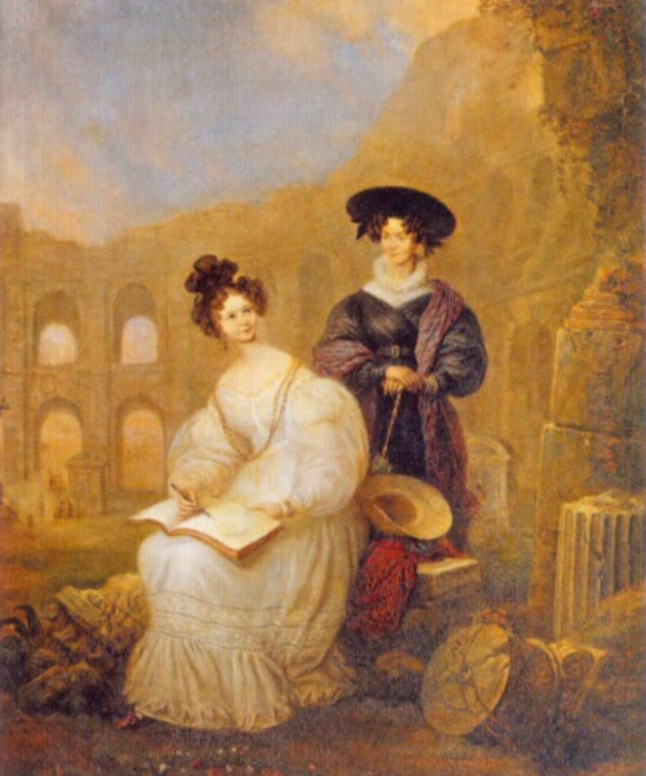|
Public domain image, Wikipedia Who would have thought that the beloved tradition of afternoon tea, often credited to an English duchess, actually originated in the sophisticated Parisian salons of the 19th century? This delightful custom, now enjoyed globally, traces its roots back to a Russian socialite whose influence extended far beyond her elegant gatherings.
Tracing the History of Afternoon Tea Tea as an afternoon meal, is thought to have originated in 1837 in the house of Mme. de Circourt, a Russian lady, whose salon in Paris was at that time much frequented by the most intellectual society of day. The fashionable dinner hours were then getting late, and she introduced a 4 o'clock light meal, at which tea was served, creating the custom in Paris of afternoon tea. It was later that Fanny Kemble in “Records of a Girlhood” attributes the introduction of the afternoon meal in England, to Anna, the then Duchess of Bedford. From “Notes and Queries” 1882— On Afternoon Tea - “In a sketch of Comte de Circourt, by Hubert Saladin, the salon of Madame de Circourt comes prominently before us as one of those frequented by the most intellectual society of Paris in 1837. A reviewer in the Revue Britannique for this month suggests that to her (she was a Russian) we are perhaps indebted for the first 5 o’clock teas.” K.H.B. Biography of Madame de Circourt Madame de Circourt, was born Anastasie Klustine, in Moscow in 1808, to Simon Klustine, an officer of high rank in the Russian army, and the Countess Vera Tolstoi. Intelligent and a natural at linguistics, Anastasie spoke fluent Russian, German, French and English by the age of 16. Her educational studies included religion, ethics, metaphysics, botany, and music, but her health was described as delicate. Subsequently, at the age of 18, with her mother, she travelled to Montpellier, Pyrenees and then to Paris to convalesce. ‘It was in Paris during the winter of 1826-27 that she made the acquaintance of Count Adolphe de Circourt’ and they soon married. Her later life, and the popularity of her Parisian salon, in which she entertained the most intellectual of society, was covered in author Count Nigra’s book, “Count Cavour and Madame de Circourt: Some Unpublished Correspondence.” It was in her salon that she started the custom of serving afternoon tea, prior to the Duchess of Bedford doing so in England. Conclusion The tradition of afternoon tea, a beloved ritual enjoyed worldwide, finds its origins in the elegant Parisian salons of the 19th century. While often attributed to the Duchess of Bedford in England, historical evidence suggests that Madame de Circourt, a Russian socialite residing in Paris, was the true pioneer of this custom. Her intellectually stimulating salon, frequented by the era's elite, served as the backdrop for the introduction of a light, 4 o'clock meal accompanied by tea. This sophisticated practice subsequently gained popularity in England and beyond, evolving into the cherished tradition we know today. Madame de Circourt's influence extended far beyond her social circles. Her intellectual pursuits, linguistic prowess, and cosmopolitan lifestyle contributed to her role as a cultural influencer, solidifying her place in history as the originator of a timeless social custom. Article Published In: Etiquipedia.blogspot.com
0 Comments
Have you ever faced the dinner table's most feared nemesis – the daunting, often befuddling, and strangely origami-like dinner napkin? You're not alone. This seemingly harmless square of fabric, found slumbering peacefully on your plate, can cause surprising distress.
What Is Napkin Etiquette? Do you wear it as a cape, tuck it into your shirt like a bib, or wave it like a surrender flag when you're too full? Just remember, it's not a tissue, a handkerchief, or a magic carpet for food crumbs. Handle with care! Napkin etiquette is the proper use and handling of napkins during meals. Here are some common and elegant guidelines: How to Use Napkin Etiquette Placement. When you sit down at a dining table, unfold your napkin and place it on your lap. In more casual settings, you can place it on your lap as soon as you are seated. Unfolding The Napkin Unfold the napkin not fully, but in half. Avoid shaking or flicking it open. Using the Napkin Throughout the meal, use your napkin to gently dab your mouth when needed. Don’t make a huge display of vigorously wiping your mouth or using the napkin to clean or dry your clothing if a spill occurs. Napkin Etiquette When Finished Eating - Resting If you need to leave the table during the meal, place your napkin loosely folded on your chair. This signals to the waiter that you intend to return. Napkin Etiquette When Leaving The Table - Finished When you have finished your meal, place your napkin loosely folded on the left side of your plate. Handling Mishaps At The Table If you accidentally spill something on the table or your lap, use your napkin to blot the spill gently. If the spill is significant, discreetly inform a server or host, and they will assist in cleaning it up. What Is Proper Napkin Etiquette For Afternoon Tea The same procedure using the napkin for any meal applies for napkin etiquette at an afternoon tea. For afternoon tea you maybe given a smaller cotton napkin to use, as the meal is finger food affair only. Top Tip >> These tips may vary depending on the cultural context and the formality of the occasion. It's always a good idea to observe and follow the lead of your host or the people around you when it comes to using your napkin at the table. Article Published In: LinkedIn In the digital age, email remains a cornerstone of professional communication. Writing a well-crafted professional email is not only a demonstration of your communication skills but also a reflection of your professionalism. In this article, we'll delve into the essential elements of writing a professional email that commands attention, conveys your message clearly, and leaves a lasting positive impression.
Mastering the art of writing professional emails is a crucial skill in today's business landscape as they will never fade out of view. By following these guidelines, remember, effective communication is key to building and maintaining strong professional relationships. The ever-increasing importance of interpersonal skills is underscored by research from the American Society for Training and Development (ASTD). In 2011, their findings revealed a significant investment in "soft skills" training, with a staggering 27.6% of a $171.5 billion budget dedicated to employee learning and development focused on this area. This emphasis reflects the reality of our increasingly connected world, where strong interpersonal skills are the cornerstone of successful interactions and relationships in all aspects of life, from your career to your social circle. What are Interpersonal Skills? “Harvard University, the Carnegie Foundation and Stanford Research in 1918 found that “85% of job success comes from having well‐developed soft and people skills, and only 15% of job success comes from technical skills and knowledge (hard skills).” Interpersonal skills encompass the abilities we use to interact and communicate effectively with others. These skills go beyond simply conveying information - they're about building genuine connections, fostering trust, and navigating social situations with confidence. Here are some critical points of interpersonal skills:
Why are interpersonal skills critical? Strong interpersonal skills benefit you in numerous ways, such as in your career, effective communication, and relationship building. The by-product of this is increased confidence; this is when navigating social situations becomes second nature. You'll feel more comfortable interacting with new people and tackling challenging conversations. You can invest in sharpening your interpersonal skills. The good news is that interpersonal skills can be learned and honed through practice and attending etiquette schools. Here are some tips for developing your interpersonal skills.
By investing in your interpersonal skills, you're investing in your future success and happiness. You'll build stronger relationships, navigate challenges more effectively, and unlock your full potential in all areas of life. Although we live in an increasingly digital world, interpersonal skills are more important than ever. These human connections are what bring richness and meaning to our lives, both personally and professionally. The correct way to set the table with forks is to set the entrée fork first, then the main fork second. There seems to be a lot of confusion surrounding which fork to use...This is the first question that students will ask when learning about dining etiquette. The choice of which fork to use depends on the dining situation and the etiquette you wish to follow. Here are some general guidelines for choosing the right fork:
Fish fork and knife.
I hope this has helped you! Remember that table settings can vary depending on the country and the formality of the event. If you're unsure which fork to use, observe what others are doing, and follow suit. |
AuthorElizabeth Soos Archives
March 2025
Categories |
|
CONTACT US Submit Your Enquiry |









 RSS Feed
RSS Feed

